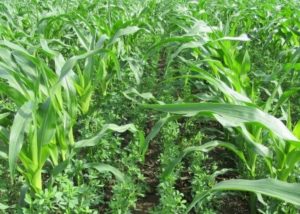In 2018, Wisconsin growers produced 13.4 million tons of silage corn and 1.93 million tons of alfalfa and alfalfa mixtures. Interseeding alfalfa with silage corn has many advantages for growers and is beneficial for the environment and livestock, but it can be challenging due to reduced light under the corn canopy. Prohexadione calcium can be used to help ensure the survival of alfalfa seedings interplanted with corn and provides a workable and cost-effective solution for growers.

Kudos® 27.5 WDG from Fine Americas, Inc. is a prohexadione calcium plant growth regulator originally registered for use on apples, grass grown for seed, peanuts, and sweet cherries, but a new registration has recently been approved for alfalfa interplanted with silage corn in Wisconsin and Pennsylvania. Application of Kudos® encourages root growth while limiting shoot growth, thus improving the alfalfa seedling’s chances of survival. Shoot growth is reduced by inhibiting the biosynthesis of gibberellins. According to studies conducted in Wisconsin, correctly timed prohexadione calcium application could increase interseeded alfalfa survival as much as 400%.
The updated Kudos® 27.5 WDG label calls for application of 12-24 oz of product per acre when alfalfa reaches 5-15 inches tall. The amount needed will depend on growing conditions, corn population and alfalfa variety. Product should be applied directly to alfalfa foliage with drop nozzles or other equipment that directs the spray to the alfalfa while avoiding the corn. According to Dr. Daniel Heider, Senior Outreach Specialist at the University of Wisconsin, “There will be a bit of a learning curve for growers as they use the equipment modifications and slower application speeds necessitated by the use of drop nozzles.” This use is approved only for Wisconsin and Pennsylvania. See the updated Kudos® label for additional use information and restrictions.
Dr. John Grabber, an agronomist at the USDA Agricultural Research Service, and Dr. Mark Renz, weed science ecologist at the University of Wisconsin, who were instrumental in previous studies of prohexadione calcium on alfalfa interseeded with corn, are currently collaborating on a study that should provide growers with specific recommendations for the optimal timing and use of Kudos®.
“The Kudos® label for interseeded alfalfa has been approved by the EPA, but further refinements on application rates and timing in conjunction with fungicide and insecticide application are underway and will provide the best outcomes for farmers,” Grabber says. “The product could be applied in a single pass relatively early when the alfalfa is fairly short or perhaps an application made later in combination with fungicide, and if needed, insecticide. This study, combined with results from previous studies, will help determine the most cost-effective way to use the product.”
Heider adds, “Growers will need to realize that this is not a one-size-fits-all practice. Differences in alfalfa varieties and its management as well as the corn crop it is being grown in will likely produce different results for different growers. They will need to use on-farm testing and experiment with equipment for planting the alfalfa and making applications. The payoff, however, will be in keeping their productive soil right where it belongs for many years to come.”
By using residue tolerance data for prohexadione calcium on similar crops, IR-4 was able to fast-track approval of this use for growers. “We cut about four years off the process,” says IR-4 Senior Associate Director, Dan Kunkel, Ph.D.
Interplanting Alfalfa Brings Multiple Benefits
This new registration should provide many benefits for growers. In the Northern U.S., alfalfa can’t be planted after the corn harvest in the fall. With the addition of prohexadione calcium, Northern growers could seed alfalfa between corn rows in the spring immediately after corn planting and until the corn first emerges. Alfalfa can serve as both a ground cover during the corn production period and a forage crop for livestock later. Interplanting alfalfa with corn reduces weed growth and thus could also reduce herbicide use. According to Heider, “There is the potential for the elimination of a herbicide in the establishment year.”
Increasing the amount of alfalfa planted would aid cropland management by reducing soil erosion and phosphorus runoff and preventing leaching of nitrate into groundwater. Studies have shown that compared with cropland containing traditional silage corn rows, corn interseeded with alfalfa produced a 60% reduction in spring and fall phosphorus runoff and an 80% reduction in soil erosion. Grabber says cover crops like alfalfa are lessening the environmental impact of these production systems by protecting soil, by taking up leftover nutrients, helping to recycle nutrients.
Alfalfa also attracts beneficial insects and is a protein-rich food source for livestock.
“We’re using this interseeding approach with prohexadione to help farmers continue to use rotations and encourage them to use them more because there is an overall benefit… of breaking up pest cycles, keeping pesticide levels down,” Grabber says, “because with continuous production of any crop, you get more pests.”
Interseeding alfalfa with corn with the addition of prohexadione calcium could also benefit growers economically. One report showed a 12% increase in first year alfalfa yields with prohexadione calcium application and a 37%-130% increase in fall stand densities.
“We expect interseeded alfalfa treated with agrichemicals that include prohexadione calcium will improve overall profitability of corn silage-alfalfa rotations by about 10 to 15%,” Grabber says. “And this is in addition to greater overall forage yield and improved environmental outcomes such as less soil and nutrient loss by erosion or leaching.”
The potential benefits to growers provided by the application of prohexadione calcium to alfalfa seedlings interplanted with corn and the resulting increase in alfalfa acreage in the landscape and its environmental advantages make this new registration of Kudos® an exciting and important development for growers in the Northern US.
PR# 08315 Alfalfa (general growth)
Michele Meyers is a contributing writer for Meister Media Worldwide.
